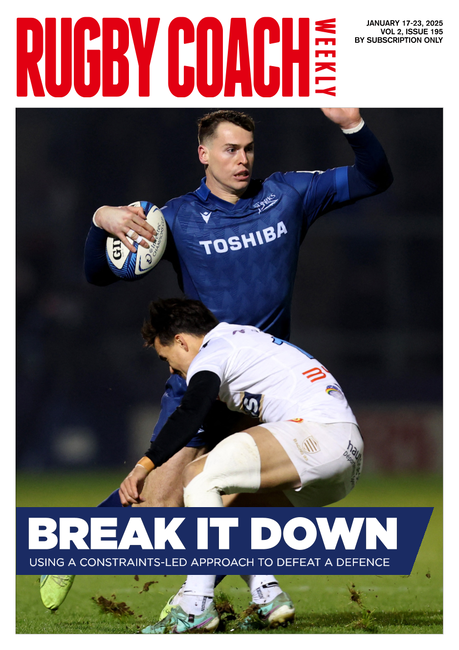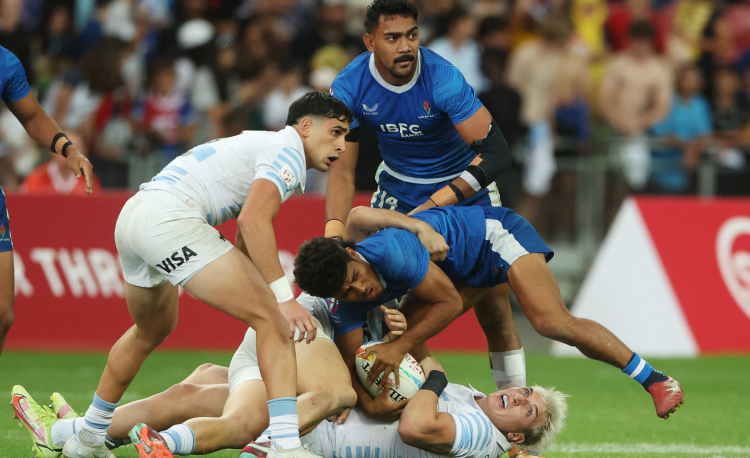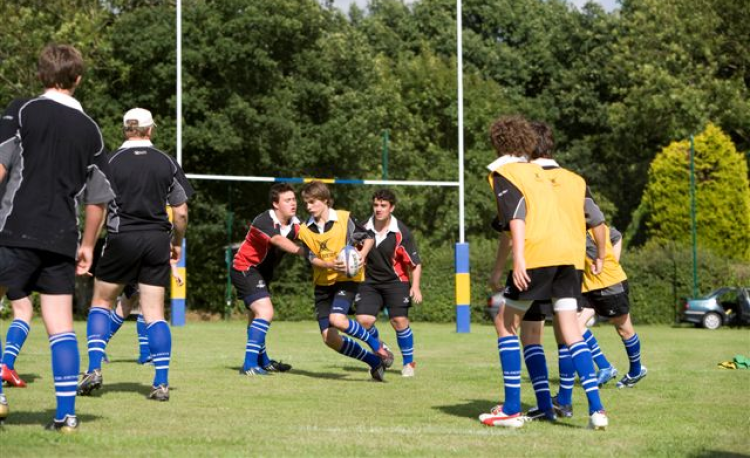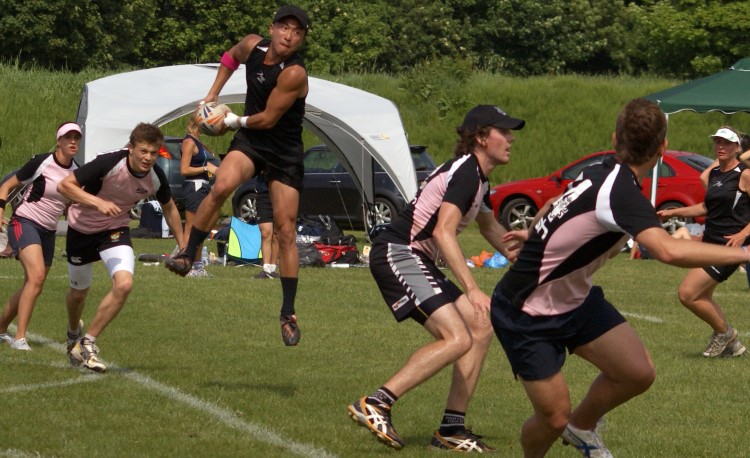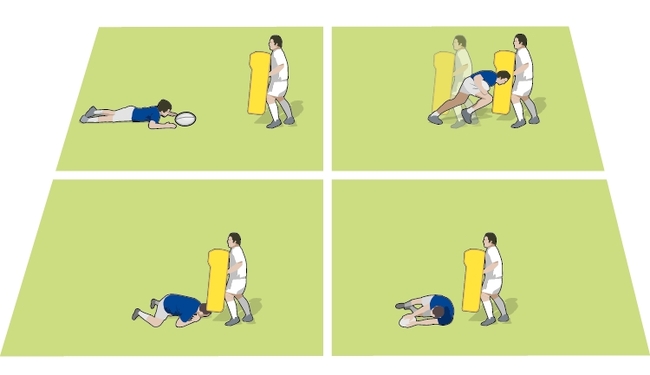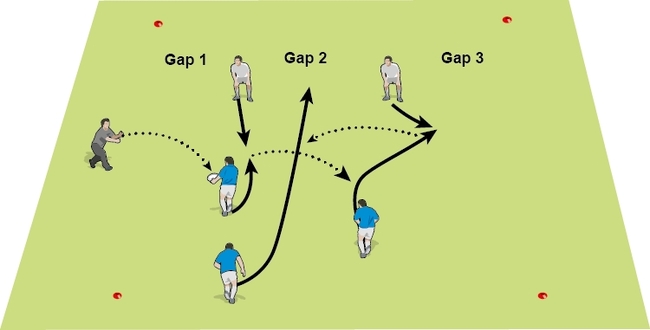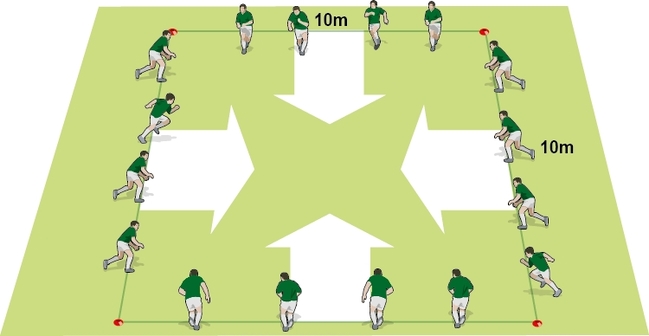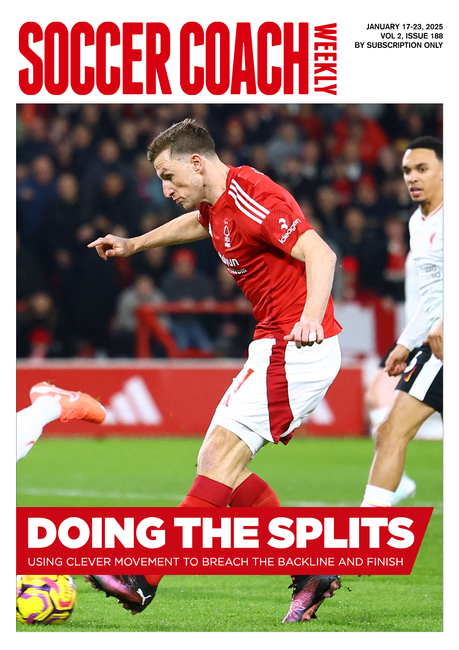U7 U8 Mini Tag Rugby Refereeing and Game Coaching
Touch Tag Sevensby Dan Cottrell
You might hope not to have to get involved in refereeing, or “game coaching” as it is becoming known, or you might be dead keen to try. These days the objective is a free-flowing game, so the person with the whistle is more of a helper than a referee. Each side having a coach is no longer advised (a lot less shouting!), freeing up helpers to run other games. This is needed because there are smaller numbers of players per game.

Free pass: This is used as a way of restarting a game. One player of the team that is awarded possession simply passes the ball to a team-mate to restart the game. To start the game for the first and second halves, or after a try, the free pass is from the centre of the field. When the ball goes out of play, the free pass is from the place where the ball went out. After an infringement, the free pass is made from the place of the infringement. The free pass is used instead of a kick, scrum or lineout.
Scoring a try: Encourage the players to call out “try” when they score. A try is worth one point. If the ground or playing surface is particularly hard you may prefer for a try to be scored when a player simply runs over the opposition goal line with the ball.
Knock-ons and knock forwards: A knock-on occurs when a player drops the ball or fumbles it as he tries to catch it and the ball both goes forward towards the attackers’ goal line and drops to the ground. At this age group, play is allowed to continue, offering the chance for the other team to win the ball.
Using the whistle: Although the emphasis at this age is on using the whistle as little as possible, it’s still valuable to start and stop games, highlight dangerous play, stop for injuries or when serious infringements occur. And it’s helpful for getting attention, too! But you could just say “Stop!” as an alternative!
Tags on the ground: There should be no tags on the ground at any time. However, occasionally a ball carrier may accidentally flick off one of their own tags while running. In this case, stop the game and allow the player to replace the tag. Restart the game with a free pass to the team in possession from where the tag came off.
Kicking and diving: You’ll probably find that the ball ends up on the ground quite a lot. Do not allow the players to kick or dive on any loose ball, and stop the game to make the point. Instead get them to gather the ball up, staying on their feet, and play on.
Contact: Tag rugby is a non-contact sport, so players should be encouraged to avoid each other. The ball carrier must not run into defenders, and defenders must not run block the ball carrier. Players should not “bash” into each other, and if any if this happens stop the game to explain the rules.

Free pass: This is used as a way of restarting a game. One player of the team that is awarded possession simply passes the ball to a team-mate to restart the game. To start the game for the first and second halves, or after a try, the free pass is from the centre of the field. When the ball goes out of play, the free pass is from the place where the ball went out. After an infringement, the free pass is made from the place of the infringement. The free pass is used instead of a kick, scrum or lineout.
Scoring a try: Encourage the players to call out “try” when they score. A try is worth one point. If the ground or playing surface is particularly hard you may prefer for a try to be scored when a player simply runs over the opposition goal line with the ball.
Knock-ons and knock forwards: A knock-on occurs when a player drops the ball or fumbles it as he tries to catch it and the ball both goes forward towards the attackers’ goal line and drops to the ground. At this age group, play is allowed to continue, offering the chance for the other team to win the ball.
Using the whistle: Although the emphasis at this age is on using the whistle as little as possible, it’s still valuable to start and stop games, highlight dangerous play, stop for injuries or when serious infringements occur. And it’s helpful for getting attention, too! But you could just say “Stop!” as an alternative!
Tags on the ground: There should be no tags on the ground at any time. However, occasionally a ball carrier may accidentally flick off one of their own tags while running. In this case, stop the game and allow the player to replace the tag. Restart the game with a free pass to the team in possession from where the tag came off.
Kicking and diving: You’ll probably find that the ball ends up on the ground quite a lot. Do not allow the players to kick or dive on any loose ball, and stop the game to make the point. Instead get them to gather the ball up, staying on their feet, and play on.
Contact: Tag rugby is a non-contact sport, so players should be encouraged to avoid each other. The ball carrier must not run into defenders, and defenders must not run block the ball carrier. Players should not “bash” into each other, and if any if this happens stop the game to explain the rules.
Newsletter Sign Up
Coaches Testimonials

Gerald Kearney, Downtown Las Vegas Soccer Club

Paul Butler, Florida, USA

Rick Shields, Springboro, USA

Tony Green, Pierrefonds Titans, Quebec, Canada
Subscribe Today
Be a more effective, more successful rugby coach
In a recent survey 89% of subscribers said Rugby Coach Weekly makes them more confident, 91% said Rugby Coach Weekly makes them a more effective coach and 93% said Rugby Coach Weekly makes them more inspired.
Get Weekly Inspiration
All the latest techniques and approaches
Rugby Coach Weekly offers proven and easy to use rugby drills, coaching sessions, practice plans, small-sided games, warm-ups, training tips and advice.
We've been at the cutting edge of rugby coaching since we launched in 2005, creating resources for the grassroots youth coach, following best practice from around the world and insights from the professional game.


